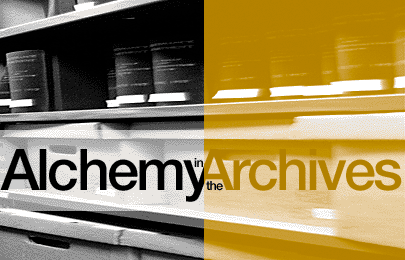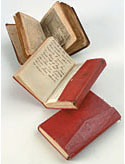Alchemy in the Archives

For 40 years, archivists have been sorting and storing the materials that chronicle the history of McGill. Join us for a poke through the University's "attic," where once-mundane objects become fascinating artifacts.
PHOTOS BY NICOLAS MORIN
ARCHIVAL IMAGES COURTESY MCGILL ARCHIVES
Gordon Burr, BA'75, MLIS'98, unlatches what appears to be a misshapen trombone case and slowly pries open its shell. Inside, a plush compartment cradles a wide scroll that is tethered to a thick, flat disk about the circumference of a CD. While a student assistant steadies the heavy disk, which hangs precariously from the page like an anchor, the senior archivist extracts the parchment, handling it with the care usually reserved for a newborn.
 Senior archivist
Gordon Bur r with Archives director Johanne Pelletier in the stacks.
Senior archivist
Gordon Bur r with Archives director Johanne Pelletier in the stacks.
But this baby is 150 years old. The "anchor" is the genuine seal of Queen Victoria embossed in wax, and the document it trails is the McGill Charter of 1852, the royal decree that transformed James McGill's fledgling Royal Institution for the Advancement of Learning into a private university. It is the jewel of the McGill University Archives, a delicate ensemble piece mortally vulnerable to acid, light, heat, humidity and, of course, laceration. "Yes," Burr exhales, finally, once he's safely transferred the oversized document to its wooden display frame, "we do have to be careful."
At a century and a half, the Charter appears none the worse for wear, evincing few signs of its antiquity. The exquisitely sketched border figures are in pristine condition. And the text, so florid in penmanship and prose, appears vivid enough on the page to have been written yesterday.

The pocket diaries of James McGill, containing mainly daily weather reports
But for all its museum-quality majesty, the Archives' pre-eminent piece shares at least one trait with the holdings that fill most of its other 17,000 boxes: it's a working document. Within the Charter's four-page thicket of old-fashioned English is written McGill's still-binding mandate, the University's rights and obligations. The department's director, Johanne M. Pelletier, BA'86, who also holds the title of University Archivist, explains that the Charter's duality -- an essential document that also tells some part of McGill's story -- is typical of the collection. "It's rare that the Archives promotes history alone," she explains. "Our central mandate is to ensure the preservation of records of long-term legal and historical value to the University, in all their forms."
The primary format has been paper. The Archives has 6,000 metres of it -- a stack that would stand taller than Mount Kilimanjaro. Though somewhat more prosaic than the elegant 1852 Charter, the reams of student records, financial statements, personnel records, legal papers, meeting minutes, memos and architectural plans are considered essential documentation and maintained with the same level of vigilance by Archives staff. Especially revealing, Pelletier notes, are the principals' papers, which touch on every donation, decision and achievement made during their tenures. "Because decision making was more centralized in the past, we see virtually everything about the University reflected in these papers," she says. "They provide a broad brush stroke of University life."
Archives FAQs
Am I a direct descendant of James McGill? Did a McGill student kill Harry Houdini? Is Jack the Ripper a McGill alumnus? Senior archivist Gordon Burr gets these questions all the time. So often, in fact, that he has posted the answers to these and other frequently asked questions on the Archives website, www.archives.mcgill.ca.
For the record, though Harry Houdini's death was not blamed on a McGill student, we do know that McGill undergraduate Jocelyn Gordon Whitehead punched the famed magician unexpectedly several times after an appearance October 20, 1926, to test the tensile strength of his self-proclaimed "iron stomach." The blows are thought to have aggravated an existing but still undetected case of appendicitis. Houdini died 11 days later of a ruptured appendix.
And while one branch of urban legend names Dr. Thomas Neill Cream, a McGill-trained physician, as the notorious murderer of London prostitutes in the late 1800s, there are serious doubts about the theory. Cream was a killer, all right, convicted in the death of a London prostitute, with many more victims likely in his wake. But Cream killed with chloroform, not cutlery.
As for the James McGill query, Burr responds with a resounding "not likely," citing research conducted by two prominent McGill family genealogists: "McGill died childless."
Words and pictures
If essential documents form McGill's skeleton, then publications, photos and memorabilia are the flesh on its bones. The Archives keeps complete volumes of publications that have kept students, faculty and alumni entertained and informed over the years: student newspapers, from the Gazette (1873-1890) to the Fortnightly (1892-1898) and the Outlook (1898-1907) to the Martlet (1908-1911) and the Daily (1911-present); and periodicals, including the University Magazine (1900-1919) and the McGill News, now 83 years old. Each edition of "Old McGill," the venerable yearbook first published in 1898, is a trove of memories.
And then there are the photos. Some 30,000 grace the Archives, from ancient daguerrotypes to digital prints, from quotidian portraits to genuine classics. The first six graduates in Applied Science, class of 1873, plying their trades around a work bench. Passionate students protesting the Vietnam War with homemade banners. A somber gathering of Donaldas, the first female graduates of McGill, bound in the soaring necklines and bustles of the late 19th century. The Modern Dance class of 1923, reaching for the heavens in breezy garments that visibly celebrate the end of Victorian- and Edwardian-era confines. The 1899 Banjo Club, instruments cocked and ready. Members of the Canadian Officers Training Corps preparing for the Great War. Pioneering female Engineering graduate Mary Jackson Fowler, circa 1946, dressed for machine shop in work smock, slacks and boots, a confident smile on her lips, a cigarette between her fingers.
There's also a print of the historic 1874 football contest between McGill and Harvard, considered the first to be played under modern rules. This may be the Archives' marquee image; it's also a prime exhibit of the composite work of William Notman, the noted chronicler of 19th- century Canada. Before photographic technology allowed "action" shots, Notman achieved the desired kinetic effect by capturing each of the footballers in his studio, then painstakingly assembling them into a coherent scrum framed by an illustrated crowd milling unrealistically close to the play. Art and history collide in the Archives.

The McGill Charter of 1852, with the seal of Queen Victoria
And somewhere in those files of photos and stacks of magazines lies the frontier between the official and ephemeral, that which was not intended for posterity but has survived just the same. For most, this is where things get really interesting. "Beyond the essential documents, we're also interested in the unofficial cultural records of the University -- scrapbooks, journals, exams, course notes, doodling in course notes," Pelletier says. "It's important to have some samples that give a glimpse into what happened inside and outside of the classroom at McGill during different eras."
Among the small collection of ephemera is a formal 1861 lecture card, required for admittance to class in a more mannered era; playbills from Red & White Reviews and programs from Winter Carnivals; a 1912 Scarlet Key sweater and a "McGill Français" picket sign from the 1969 demonstration; an LP recording from the wildly popular 1957 theatrical production of My Fur Lady; a 1917 recruiting poster for Princess Patricia's Canadian Light Infantry; and an advertisement for the 1939 McGill Smoking Campaign (to raise funds for the Currie Gym). There's even an epic poem inspired by the great snowball fight of 1900 that begins dramatically enough:
Arm! Arm! Ye mighty men of Arts, prepare to face the foe,
A troop of shrieking maniacs approaches from below.
Too well we know those flaming ties, those shaggy crested heads;
Behold the terror of the town, a brawling tribe of Meds.
"We're not the Antiques Roadshow," Burr says. "But the memorabilia really brings our history alive."


